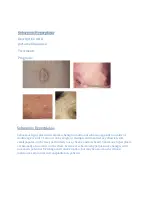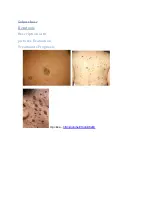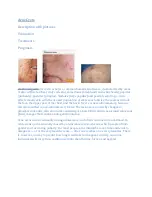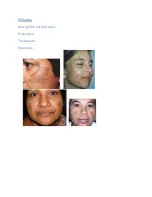
A lentigo (plural: lentigines) is a small pigmented spot on the skin with a clearly-defined
edge, surrounded by normal-appearing skin. It is a harmless (benign) hyperplasia of
melanocytes which is linear in its spread. This means the hyperplasia of melanocytes is
restricted to the cell layer directly above the basement membrane of the epidermis where
melanocytes normally reside. This is in contrast to the "nests" of multi-layer melanocytes
found in moles. Because of this characteristic feature, the adjective "lentiginous" is used to
describe other skin lesions that similarly proliferate linearly within the basal cell layer.
Lentigines are distinguished from freckles based on the proliferation of melanocytes.
Freckles have a relatively normal number of melanocytes but an increased amount of
melanin. A lentigo has an increased number of melanocytes. Freckles will intensify and
fade with sunlight exposure, whereas lentigines will stay stable in their color regardless of
sunlight exposure.
Evaluation:
The initial appearance of lentigines varies widely and depends on the
following: As always skin traction, good lighting, and magnification are keys to
proper identification of this irregularity.
Race
History of exposures
Genetic predisposition
Other factors, depending on the type of lentigo
Solar lentigo
Solar lentigo (e.g., actinic lentigo, senile lentigo, sun spot, liver spot) is the most common
benign sun-induced lesion that occurs in sun-exposed areas. Solar lentigo most commonly
appears on the face, arms, dorsa of the hands, and upper part of the trunk. The spots
initially are smaller than 5 mm in diameter. The surface of the lesions is either flat or
depressed, and it may be split by fine wrinkles.
The lesions are usually brown, but the color may range from yellow-tan to black. Older
lesions are often dark brown or brownish black. Solar lentigines slowly increase in number
and in size. Many lesions eventually coalesce to form larger patches. Although these lesions
are most common in individuals aged 30-50 years, they are now seen in younger
individuals because of their increased exposure to sun tanning and the use of artificial
sources of UV light. Although they are often called liver spots, they are not a manifestation
of systemic disease.
Summary of Contents for Skin classic
Page 7: ...Telangiectasia Description with Pictures Evaluation Treatments Prognosis ...
Page 21: ...Flat Hyperpigmentation Descriptionwith pictures Evaluation TreatmentsPrognosis ...
Page 29: ...Skin Tags Description with pictures Evaluation Treatments Prognosis Skin Tag ...
Page 35: ...Melasma Description with pictures Evaluation Treatments Prognosis ...
















































